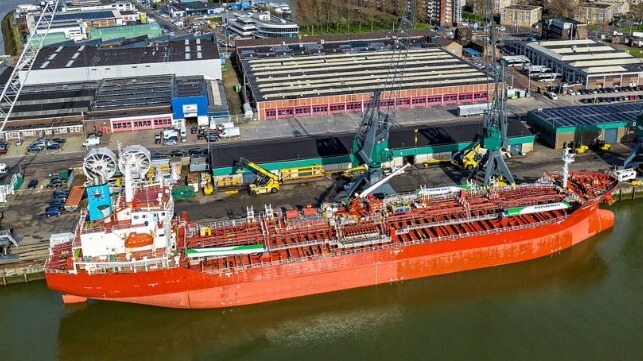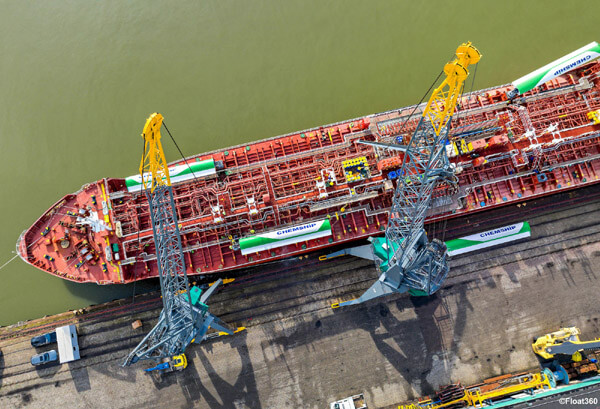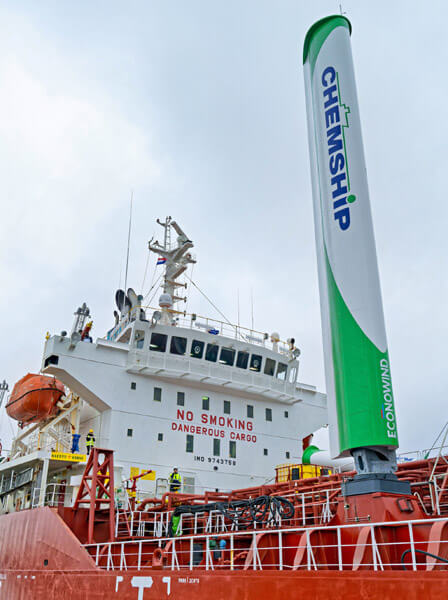First Wind Sails Fitted to a Chemical Tanker Operated by Chemship

Chemship, a Netherlands-based operator of liquid bulk carriers, reports it completed what it believes is the world’s first installation of wind-assisted propulsion on a chemical tanker. The commissioning took place today, February 19, in Rotterdam, and the company reports after a testing period, it aims to outfit more tankers with this system.
Four 16-meter (53-foot) aluminum wind sails were installed aboard the Chemical Challenger. The vessel, registered in Malta, was built in 2015. It is a 16,000 dwt chemical tanker (134 meters/440 feet in length). It operates on Chemship’s trans-Atlantic route between the U.S. East Coast and the Mediterranean.
“With the VentoFoils, we will use less fuel and thus reduce CO2 emissions,” says Niels Grotz, CEO of Chemship. “For this vessel, we anticipate an annual CO2 reduction of 850 tonnes. This is equivalent to the yearly CO2 emissions of over 500 passenger cars.”
The VentoFoils from Econowind create a direct wind surface of 180 m2. In addition, the companies highlight that smart vacuum technology quintuples the force of the wind, creating a gross wind surface of 900 m2. They report this is equivalent to an imaginary sail of 30 by 30 meters.

Chemship expects to achieve an average CO2 reduction of 10 percent with these turbo sails. The company reports it chose the technology because it is lightweight and can be retrofitted to existing ships.
“These wind sails were easy to install without adding reinforcements to the ship. They are lightweight, have a small deck ‘footprint,’ and do not obstruct the crew’s line of sight. At the push of a button, they can fold or set the sails as needed. Above wind force seven, the sails fold automatically, which is much safer,” said Michael Marelis, Operations Director for Chemship.
It will be part of a broader effort within the company to reduce emissions. They are also responding to the increased regulation including the January 1 introduction of the EU program which requires shipowners to pay for their emissions. Chemship reports it is targeting a 15 percent reduction in CO2 emissions on its Atlantic route.
“Our customers increasingly demand CO2 reports,” says Grotz. “The better our ships perform, the higher the rating from our customers. Fewer emissions are not only beneficial for the environment, but you will also notice it directly in your wallet.”

The company notes that the wind sails also provide a visible element demonstrating to customers the efforts are reducing emissions. They note that the sails are part of a larger effort but at the same time said “They immediately capture everyone’s imagination.”
It is the latest in a series of efforts using competing wind assistance technologies as shipowners look for solutions. Last week, Japan’s “K” Line reported it purchased Airseas which is developing a wind kite system while Airbus and Louis Dreyfus Armateurs made the largest order to date for wind rotors which will be installed on three RoRo cargo ships. Vale, Cargill, and others also plan to expand the use of wind-assisted propulsion after having tried systems on large bulkers.
